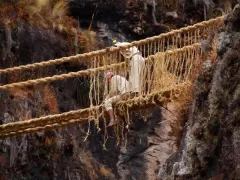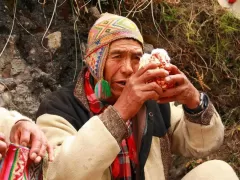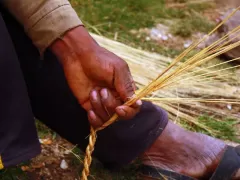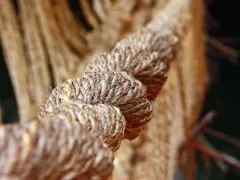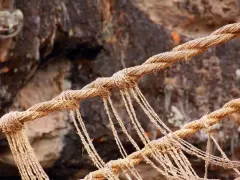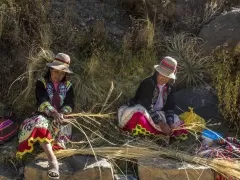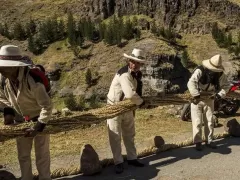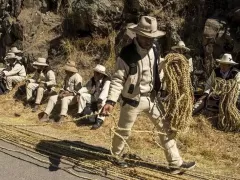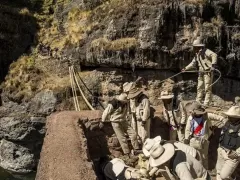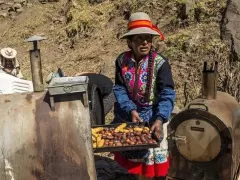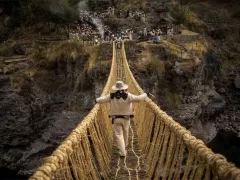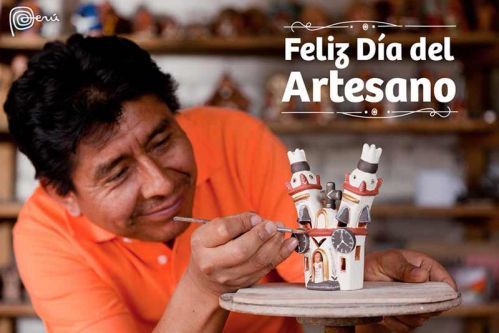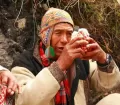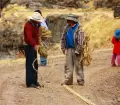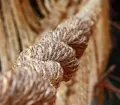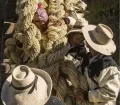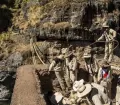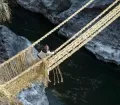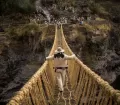In the first half of June members of four Quechua communities high in the Peruvian Andes about 180 km (110 miles) from Cusco come together to ceremonially cut the ropes of the Q’eswachaka bridge, the last remaining traditional Inca rope bridge, let it fall into the Apurimac river below and then rebuilt it by hand in a 4-day ceremony just like their Incan ancestors did over 600 years ago.
During Inca times rope bridges were an essential part of the extensive Andean road system, the Qhapaq Ñan, spanning over rivers, canyons and abysses. The simple suspension bridges were built by hand using a local grass called ichu that was braided or woven into strong ropes called q’oya.
In an elaborate process the ropes were skillfully connected, reinforced with wood and attached on each side of a canyon to stone anchors to build quite strong bridges that allowed pedestrians and livestock to cross. They even withstood the weight of the conquering Spaniards on their horses.
To ensure the strength and safety of these rope bridges, they were maintained once a year by local villagers replacing the natural ropes and repairing damages to the wood. This old Inca tradition still lives on, even though just in one place in Peru and at one specific date each year.
Every June members of four Quechua communities - Huinchiri, Choccayhua, Chaupibanda, and Ccollana Quehue - come together to rebuild the Q’eswachaka bridge located near Huinchiri in the Canas province about 180 km (110 miles) south of Cusco. For them the Q’eswachaka bridge is a beloved and respected structure that links the past and the future. It’s the soul and spirit of their Incan ancestors and represents life and power.
As during Inca times, on the first day of the traditional rebuilding of the bridge, the men of the participating communities head out looking for the ichu. Once enough ichu has been collected, the women weave the grass making ropes, while the men join the ropes together and braid it.
On the second day the ropes of the old bridge are cut and the bridge falls into the Apurimac river below. Then new ropes, which become the framework of the new bridge, are placed. On day three the handrails and the surface of the bridge are added in a communal effort.
And as hundreds of years ago the whole rebuilding process is accompanied by ancient ceremonies and offerings to Pachamama (Mother Earth) and the Apu Q’eswachaka (mountain spirits). Once the bridge is finished on the fourth day, participants celebrate with local food, chicha (a fermented corn beverage), Andean music and traditional dancing.
The bridge can be visited year-round as part of a booked tour or independently. But if you would like to be part of this amazing tradition, you can either book a special 1 to 3-day tour with one of the many tour operators or just turn up at the site at the rebuilding date and immerse yourself in the astonishing ways of Inca society and engineering.

















